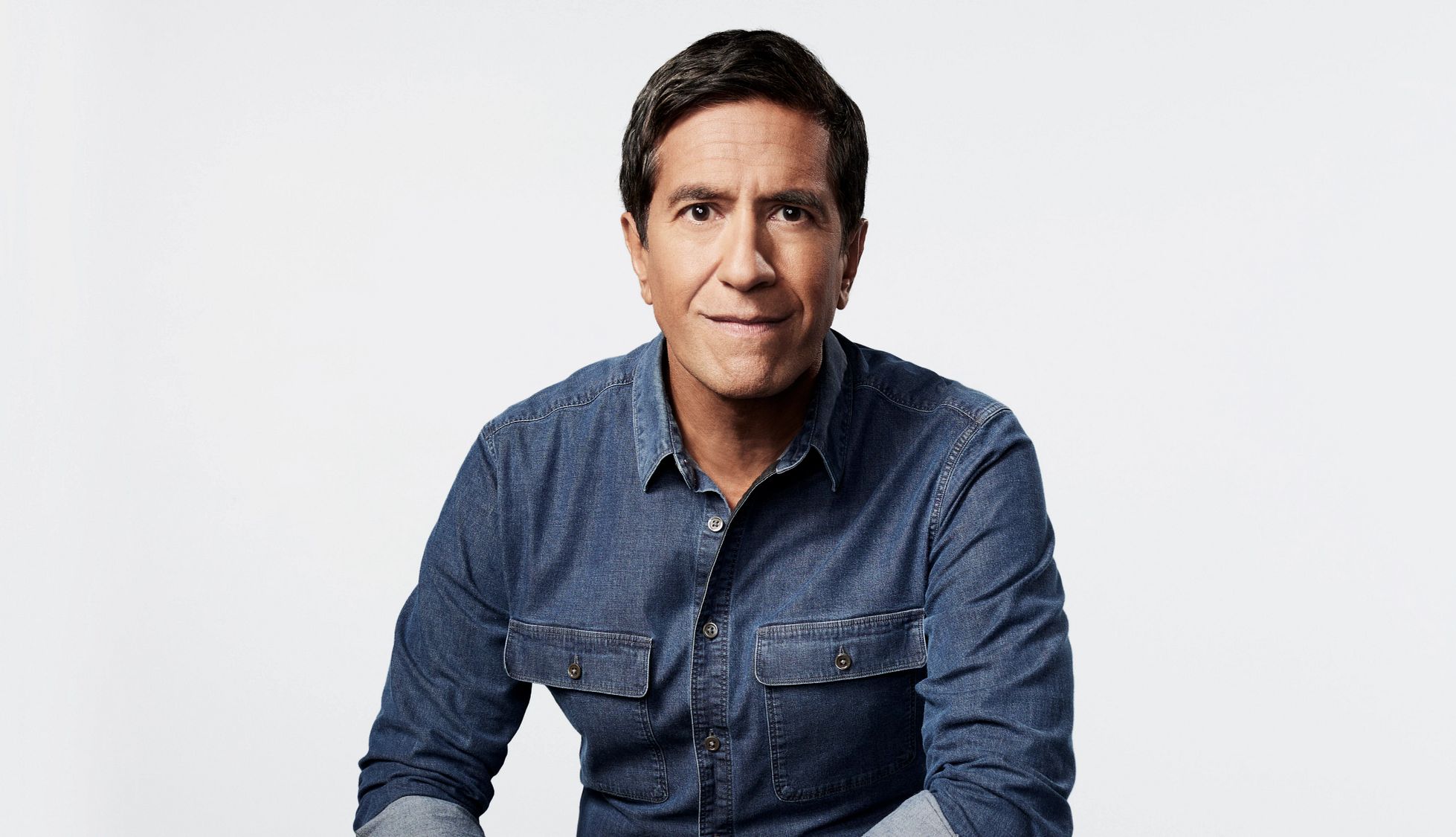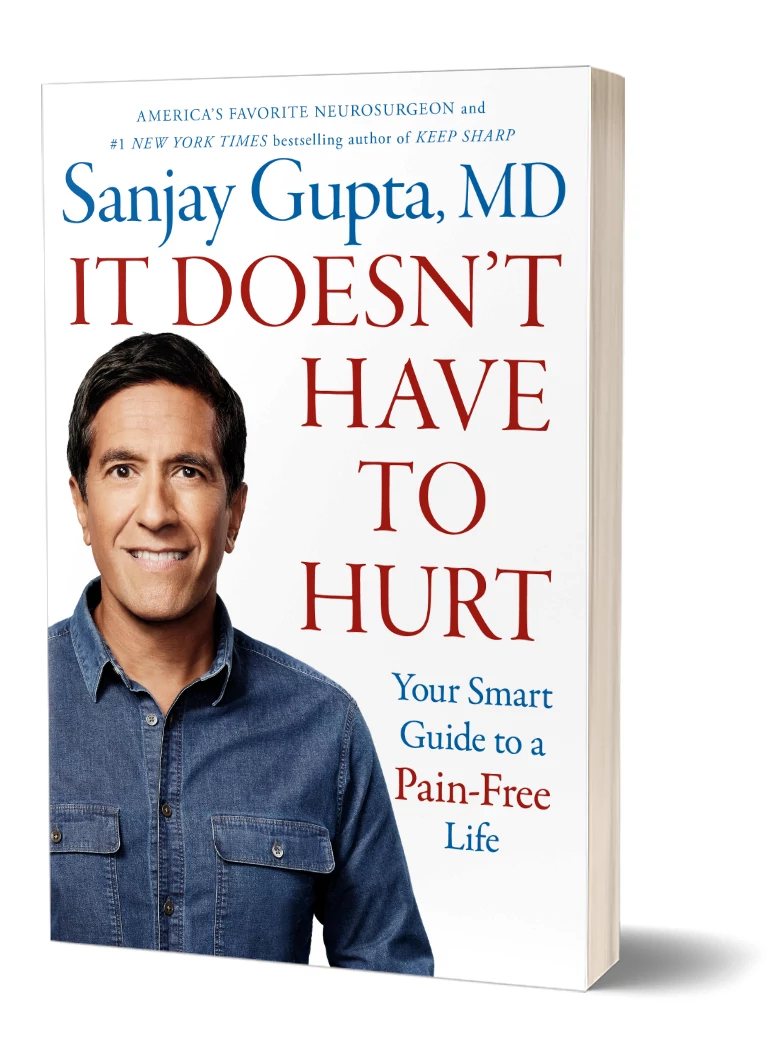AARP Hearing Center


In his new book, It Doesn’t Have to Hurt: Your Smart Guide to a Pain-Free Life (on sale Sept. 3), Sanjay Gupta, M.D., offers science-backed resources for treating chronic pain and discovering new tools for lasting relief. In the excerpt below, Gupta, 56, explores how pain became such an important topic in his life, both professionally and personally. (You can also read our related stories 10 Ways to Relieve Pain and 11 Ways Your Diet Can Relieve Pain.)
It Doesn’t Have to Hurt: Your Smart Guide to a Pain Free Life
Bess Talbot feared she was going crazy.
At age forty-seven, she was having debilitating migraine headaches. She’d had her first one two decades earlier while she was in law school, and for a while the migraines happened only occasionally. But after she had children, they “came back with a vengeance,” she told me. Now she was suffering from them every day.
The near-constant pain was affecting every part of her life. Drugs prescribed by various doctors made her woozy and dizzy, fogging her brain. She forgot grocery lists and once left her keys in a fitting room at a department store. Not able to focus until she made her way to the parking lot, she fought back tears, trying to orient herself. Where am I? Where are my things? Where is my car? “It puts you in a very dark place,” she says.
Even when her migraines were less frequent, they could last for days and still dominated her life. “At times I thought, ‘Am I going crazy? Is this something more than a migraine? Do I have a tumor?’ At one point I was even wishing that they would find something like that just so they could operate and alleviate the issue.”
After years of trying, and failing, to find relief for her migraines, Talbot was at the end of her rope. That’s when her neurologist, stymied by her condition, recommended she travel from her home in Alabama to the Michigan Headache and Neurological Institute (MHNI) in Ann Arbor to see a physician he’d heard about named Joel Saper. Desperate, Talbot decided to make the trip. Maybe, just maybe, he could help.
Even before arriving in Ann Arbor, Talbot had phone conversations and evaluations with the team Dr. Saper had assembled. She spoke with neurologists and psychologists — doctors of the brain and the mind. She was evaluated by other specialists to fine-tune her treatment with physical and occupational therapy, as well as nutritional and pharmaceutical strategies. But the most important member of the treatment team was Talbot herself. As simple as it sounds, this is Dr. Saper’s most revolutionary concept: treating the patient not as a passive participant but as an active investigator working shoulder to shoulder with the experts. By focusing on not only the “what” of treatment but also the “who” — a patient’s history, outlook, and expectations — he created an optimal healing environment. He helped people believe they could drive their own care.


In "It Doesn’t Have to Hurt," Sanjay Gupta, M.D., shares effective options for relief that you can start practicing today to greatly reduce your chances of suffering pain tomorrow.
In the course of her weeklong hospitalization for treatment, Talbot told Saper about a high school cheerleading accident from decades earlier. The team had been practicing a challenging new formation, and as a “flier” — the cheerleading daredevil who perches atop the human pyramid — Talbot had taken a steep plunge to the floor when the formation suddenly crumbled. She landed hard on her tailbone and felt a stab of pain in her back. Then the formation next to hers toppled too, and Talbot felt her head slam as a flier in that group crash-landed on her.
The team members disentangled, practice was canceled, and Talbot slumped home in excruciating pain. She had to skip the Guns N’ Roses concert she’d planned to see that weekend with a friend, and when her doctor prescribed a bulky back brace, her mother had to alter her prom dress to accommodate it. But eventually the episode receded into the backdrop of her active life: College. Law school. Running, including marathon training and entering races as a way to manage stress.
A few years later, when she began to experience occasional migraine headaches, she did wonder if there might be a connection to her old injury. But even as the headaches worsened over time, whenever she brought up that idea with new doctors, they dismissed the link as too flimsy to pursue.
Then she sat down with Saper.
He was the first doctor to really dig into the aftermath of her fall. He learned that a few hours after the accident, her mother had insisted on taking her to the hospital emergency department. A workup with scans revealed hairline fractures in three upper thoracic vertebrae. Though none were considered serious enough to require surgery, she was admitted for a short hospital stay, followed by wearing that rigid back brace for six months. To Saper, these layers of detail were a significant part of the story — a history that held clues to her current condition.
A deeper investigation revealed a family history of migraines, which likely also increased the risk for Talbot. Without the cheerleading accident, however, that risk might never have manifested. Saper describes a person’s propensity for migraines as a big rock perched on a high hill. “Genetics put the rock near the cliff,” he says. And then “whether it’s a glass of wine or a menstrual period, a bad emotional time in a person’s life, something sort of tips it over the hill and it starts rolling.” For Talbot, the cheerleading accident and the trauma to her spine, neck, and the base of her brain had tipped the boulder. Over the years, efforts at pain relief had never addressed that deeper issue.
As Saper described to Talbot how the pieces of her pain puzzle fit together, her misery and confusion gave way to something new — a hopeful sense of possibility. He used Talbot’s history to inform her treatment plan, which now included dedicated physical therapy and exercises designed to specifically strengthen her spine and neck. Over the years, she had tried countless medications for migraines, including triptans, opioids, and others to address inflammation and depression, but no one had ever suggested adding a practical rehabilitation of the base of her neck.
The benefits of Saper’s approach — the thorough initial evaluation, the continual calibrations of her medications, and the dedicated neck physical therapy — collectively made all the difference. Talbot gained more confidence in reading and responding to her physical and emotional cues for an approaching migraine. What’s more, when she began to experience her pain changing as she and Saper fine-tuned the treatments, she felt newly encouraged to focus more at home on exercise, stress management, and meditation. Even when she can’t do all of them all of the time, they are an antidote to hopelessness. “It was life changing for me,” Talbot says. And she told Saper so. “I said, ‘You’ve given me my life back.’ And I wonder, if I’d met him twenty years ago, you know, what a better mother I would have been. What a better wife I would have been. What a better everything I would have been but for the migraines.”
Talbot’s healing journey began simply, with a fresh conversation about pain. Dr. Saper had brought medical precision, multidisciplinary expertise, and a deeply collaborative partnership with his patient to frame her relationship with pain in a new way, rewriting the pain script and providing new options for treatment and prevention. I start with Talbot’s story because it offers a sense of optimism for the hundreds of millions of people suffering from chronic pain, and particularly those who have felt forgotten, suffering inside bodies they believe have betrayed them.
There is a very real path forward through pain and beyond. In this book, I walk you through the steps that I am confident will take you there.
A dizzying amount of medical progress has been made since I became a neurosurgeon more than twenty-five years ago. We can remove tumors once considered inaccessible and fuse spines previously thought to be too broken. We have a pretty good idea where certain emotions and addictions lie in the brain and can even tinker with them using deep brain stimulation. Pain, because of its complexity and subjective nature, has presented a larger challenge, and yet even there, we have made important advances.




































































More From AARP
Ease Your Pain with Better Sleep
Dr. Sanjay Gupta emphasizes the significance of sleep in managing chronic pain.Boost Brain Health with the S.H.A.R.P. Method
Use the S.H.A.R.P. method to kick-start a healthy way of eating
Sanjay Gupta Shares Insights on Alzheimer’s
‘The Last Alzheimer’s Patient’ Reveals Hopeful News